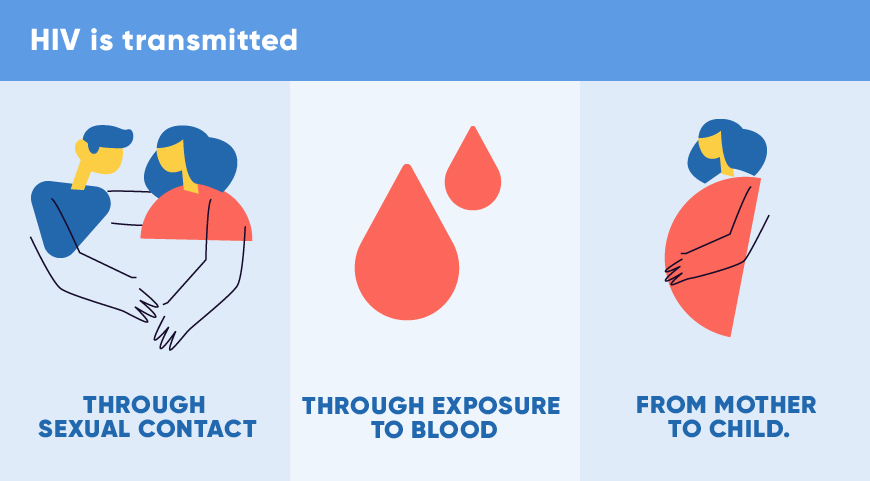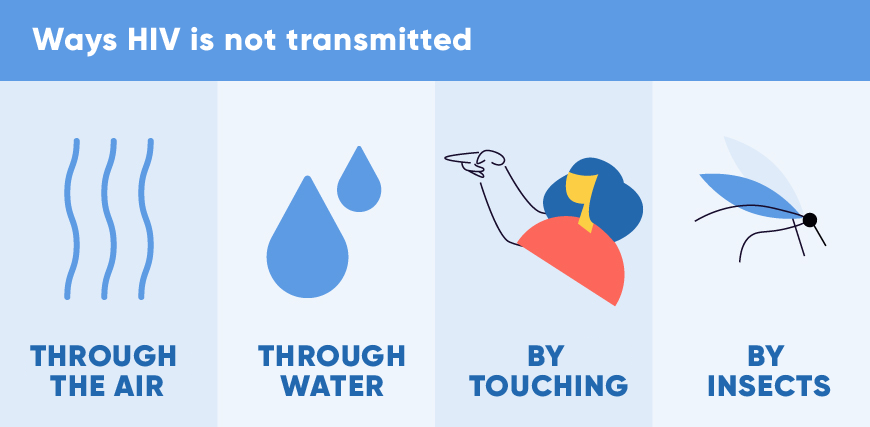How is HIV transmitted?
HIV is transmitted through infected person’s blood, semen, vaginal fluids and breast milk.

Transmission of HIV through sexual contact
HIV is transmitted through semen, pre-seminal fluid, vaginal fluids, rectal fluids and blood. When having unprotected sex with a partner who has contracted HIV, you are exposed to their bodily fluids and run a risk of contracting HIV yourself.
HIV can be transmitted during vaginal sex, anal sex and oral sex.
Anal sex is the riskiest type of sex because the rectum’s lining is thinner than that of the vagina. It is especially risky being the receptive partner during anal sex (passive anal sex). Active anal sex is somewhat less risky.
The risk of infection during vaginal sex is present for both the man and the woman. The risk of infection is higher during menstruation.
The risk of infection during oral sex is very small compared to vaginal or anal sex. But HIV as well as all other sexually transmitted infections can spread during oral sex. The risk is higher if the person performing oral sex has oral ulcers or bleeding gums or if the person receiving oral sex has genital sores. It is not recommended to brush one’s teeth immediately before oral sex.
Sex toys come into contact with vaginal and rectal fluids and mucous membranes. That is why it is possible to become infected when sharing sex toys that have not been cleaned properly. If you are the only person using your sex toys, you are at no risk for infection.
Fisting (sex using a hand or fingers) is pretty safe, except when there are open wounds on the hand. But be careful – in the event of great force or if the mucous membrane of the vagina or rectum is hurt, causing a bleed, this may lead to the transmission of HIV during subsequent vaginal, anal or oral sex. If to fist several partners in a row and there is anal mucous residue or blood on the hand from a partner infected with HIV, this may also infect subsequent partners.
The risk of getting HIV during rimming is close to non-existent. But, for example, gonorrhoea and several intestinal infections, including hepatitis A, are transmitted that way.
During group sex it is necessary to use a new condom for each partner. The previous partner will leave their bodily fluids on the condom and these may infect the next partner.
Transmission of HIV through exposure to blood
- Shared syringes
- Tattoos and body piercings
The second major way of transmitting HIV is by injection with needles that carry the virus, and puncture wounds and cuts. All actions whereby an infected sharp object or infected bodily fluids come into contact with the blood circulation of someone who is not infected. For instance, be careful with sharp objects that you come across and with which you may accidentally hurt yourself.
People at high risk for getting HIV are those who inject narcotic drugs using a syringe or a needle already used by someone else. It is also very risky to share other injection equipment, such as sharing a filter, cooker, etc. If you have decided to inject yourself, be aware of how to do it more safely.
HIV can be transmitted when getting a tattoo or a body piercing if blood contaminated instruments are used repeatedly. That is why it is recommended to go to a professional tattoo artist or body piercer who always uses either disposable or properly sterilised instruments.
Transmission of HIV from mother to child
- During pregnancy
- During childbirth
- While breastfeeding
The mother having HIV does not impair the development of the foetus. The main risk lies in infecting the foetus. The transmission of HIV from the mother to the foetus can be avoided and if the below prevention measures are applied, there is a 98–99% chance that the child will be born healthy.
ARV therapy must be started in the first half of pregnancy. If the therapy results in the amount of the virus in the blood being below the detectable level (HIV RNA PCR < 20 copies per ml), there is no risk of HIV transmission and the woman can give birth vaginally. In other cases a caesarean section must be performed because this prevents the child from being exposed to the mother’s bodily fluids during delivery. The mother cannot also breastfeed but she must use breast milk substitutes.

HIV does not survive in the air or water
HIV can only survive in the human body. It is destroyed in the open air, at room temperature and in the water. So, HIV is not transmitted by talking, singing, coughing or sneezing.
HIV is also not transmitted through other bodily fluids, unless they contain blood. Such bodily fluids are: excrement, urine, vomit masses, nasal secretion and phlegm, saliva, sweat and tears.
There is also no need to fear swimming in the same pool with someone who has HIV.
Don’t be afraid to share things and rooms with a person who has HIV
It is not possible to get HIV in everyday activities taking place in an ordinary household, in public transport or at work or school. HIV is not transmitted by using shared equipment such as a desk, chair, computer, phone or other items. It is also safe to share drinkware and tableware.
HIV is not transmitted through the use of shared spaces, such as the bathroom, or by going to the sauna or working out together because outside the human body the virus is quickly destroyed and it does not spread in the external environment.
Don’t be afraid to hug
HIV is not transmitted by touching. There is no reason to fear shaking hands, hugging, patting or other touching of someone who has HIV.
Insects are annoying but not dangerous
Blood-sucking insects, for example mosquitoes and ticks, do not carry HIV. Mosquitoes only suck the blood of a human, they do not discharge any previously sucked blood. The same goes to tick bites – the tick does not carry HIV and it does not discharge any blood into the human it is biting.

